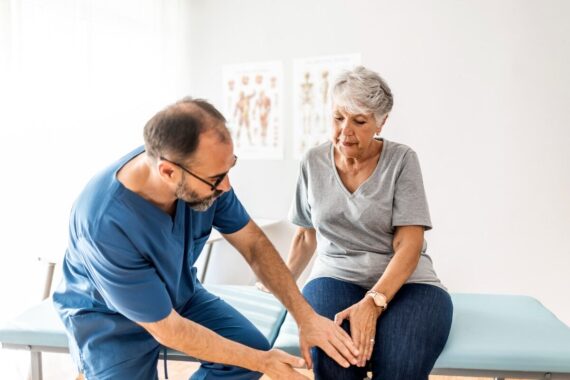GPs should offer all osteoarthritis patients tailored therapeutic exercise to help manage and reduce symptoms, NICE has said.
New guidelines on osteoarthritis, which were out for consultation earlier this year, also promote weight loss to improve quality of life and physical function.
Painkillers should only be used at the lowest possible dose for the shortest possible time to support therapeutic exercise with topical NSAID as the first option, they said.
Paracetamol and weak opioids should not be offered routinely and glucosamine and strong opioids avoided altogether, the committee added.
The guideline committee said that therapeutic exercise should be recommended that specifically aims to prevent progression and manage symptoms and it should be tailored to the needs of the person, such as joint-site-specific exercises.
Combining this as part of a structured treatment package may be more suitable for some people and motivate them to continue with therapeutic exercise, it added.
NICE also noted that supervised exercise was likely to have greater benefits for people with osteoarthritis because it may increase adherence and social support.
Patients should be advised that joint pain may increase at first when they start exercising but that doing regular and consistent exercise, even though it may initially cause discomfort, will be beneficial.
The recommendations also said that GPs should not routinely offer acupuncture or electrotherapy, but can consider walking aids for those with lower limb osteoarthritis.
GPs have previously told Pulse that providing patients with access to suitable exercise programmes could be difficult.
They also said that the use of painkillers would ‘take some time to change because of patient expectations’.
Outlining the evidence for the decision, the committee said: ‘The evidence showed that exercise has a clinically important benefit for people with osteoarthritis, as well as general health benefits and a superior safety profile compared with other common treatments, such as analgesia.
‘In particular, the committee highlighted the importance of therapeutic exercise to help manage and reduce symptoms and improve or maintain physical functioning over the long term.’
But they added that more research was needed comparing the clinical and cost-effectiveness of supervised group and individual exercise with unsupervised programmes.
And they said that evidence had shown that treatment packages had a clinically important benefit on physical function compared with education or behaviour change interventions alone, as well as consistent beneficial changes in quality of life, pain and physical function compared with standard care.
NICE draft guideline: Osteoarthritis assessment and management
1.2.2 Explain to people with osteoarthritis that:
- It is diagnosed clinically and does not need imaging and
- The core treatments for the condition are therapeutic exercise and weight loss (if appropriate) along with information and support
1.3.1 Offer tailored therapeutic exercise to all people with osteoarthritis (for example local muscle strengthening, general aerobic fitness)
1.3.2 Consider supervised therapeutic exercise for people with osteoarthritis
1.3.3 Advise people with osteroarthritis that joint pain may increase when they start therapeutic exercise. Explain that:
- Doing regular and consistent exercise, even though this initially may cause discomfort, will be beneficial for their joints
- Long-term adherence to exercise increases its benefits
1.3.4 Consider combining therapeutic exercise with an education programme or behaviour change approaches in a structured treatment package
1.3.5 For people with osteoarthritis who have excess weight or obesity:
- Advise them that weight loss will improve their quality of life and physical function, and reduce pain
- Support them to choose a weight loss goal
- Explain that any amount of weight loss is likely to be beneficial, but losing 10% of their body weight is likely to be better than 5%.
Visit Pulse Reference for details on 140 symptoms, including easily searchable symptoms and categories, offering you a free platform to check symptoms and receive potential diagnoses during consultations.
Related Articles
READERS' COMMENTS [1]
Please note, only GPs are permitted to add comments to articles


















“Earth calling NHSE….you’ve gone beyond parody”
So let’s get this straight.
Obese middle aged punter with dodgy painful knees for which voltarol gel isn’t helping staggers into surgery looking for a diagnosis and pain relief.
I can’t X-ray her to confirm OA, can’t prescribe any tablets whatsoever, then tell her to lose weight and do more exercise.
So when they tell me they can barely walk because of the pain and have been dieting unsuccessfully for decades, what then?
She would storm out if she could walk properly……followed no doubt by a letter of complaint and disgust, that I should really forward to the NHSE geniuses who suggested this balderdash.
Yet again, more nonsensical guidelines from ivory tower nerds who skived real world coal-face medicine years ago to sit on committees dreaming up meaningless crap like this.
Brilliant. Another world-beater, NHSE.